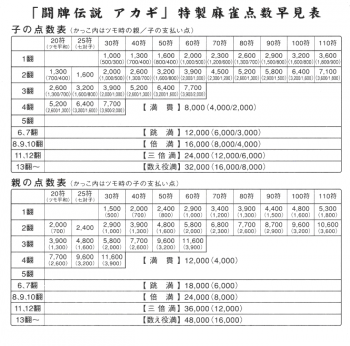Score table memorization

Despite the size of the scoring table, it is possible to memorize the table, in a manner similar to that of a multiplication table. However, any attempt to learn the scoring table is fruitless without knowing particular prerequisites, like basic game procedures, game objectives (tenpai and defense), and the yaku. As a recommendation, scoring is among the last of the more basic concepts of the game for any newer player to learn.
Overview
Learning the scoring table requires the division of the table into sections. Once a section of the scoring table is learned, then a player can move on to the next section and memorize that one. It is an ongoing process, until the entire table is learned.
Counting Han
Counting han is simple memorization of the yaku and their han values. As a reminder, some yaku may stack and combine with other yaku.
Mangan and more
| Dealer | Non-Dealer | |||
|---|---|---|---|---|
| Name | Ron | Tsumo† | Ron | Tsumo |
| Mangan | 12000 | 4000 | 8000 | 4000/2000 |
| Haneman | 18000 | 6000 | 12000 | 6000/3000 |
| Baiman | 24000 | 8000 | 16000 | 8000/4000 |
| Sanbaiman | 36000 | 12000 | 24000 | 12000/6000 |
| Yakuman | 48000 | 16000 | 32000 | 16000/8000 |
| † Dealer tsumo applies to all non-dealer players | ||||
For mangan and beyond, a point cap is applied, such that fu is no longer counted. So, this section of the scoring table easy to remember. For easier memorization, these higher values possess specific names, namely: haneman, baiman, sanbaiman, and yakuman. Likewise, they are worth factors more than mangan.
- Haneman = 50% more than mangan
- Baiman = 100% more than mangan (double)
- Sanbaiman = 150% more than mangan
- Yakuman = 200% more than mangan (four times)
The lowest score for mangan is 8000 points for a non-dealer by ron. The dealer value is 4000 points more, or 50% more, at 12000 points. For the tsumo values, the 8000 points for mangan ron is cut in half. That amount is paid by the dealer. The remaining 4000 points is again split in half for the other players to pay 2000 points each. For the dealer value, it is simply taking the 12,000 points normally scored by ron and dividing it into 3 for the other players to pay.
Counting fu
To count fu, a player must understand how fu is generated. In essence, fu comes from the hand's composition and winning method.
The convenience of counting fu rests on rounding up. Even a fu count of 32 fu gets rounded up to 40 fu. So, when counting fu, it is helpful to note when the count crosses a multiple of 10.
30 and 40 fu
Among the hands valued at 1 han to 4 han, the most common scores involve 30 fu or 40 fu. So, among the han-fu combinations, this is the most logical section to start.
Naturally, the first score to consider involves 1 han and 30 fu. Of all the hand values possible, this is the smallest. While the 20 fu values exist, 1 han and 20 fu does not, as no hand can be valued as such.
Point equivalences
20 fu
Hands with 20 fu only applies to pinfu. This yaku is defined as a hand that does not earn fu. Although, it still earns the 10 fu with closed ron. Otherwise, the hand does not produce fu by any other means.